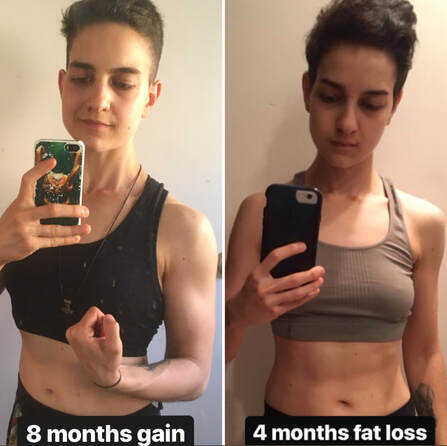|
Useful Links: One Month Update | Three Months Update Success is no accident. It is hard work, perseverance, learning, studying, sacrifice and most of all, love of what you are doing or learning to do. In June 2019 I celebrated my first lifting birthday after years of endurance work and cardio-based fitness classes. So I felt it was time to write a bulk update. I made several changes to the way I train, taking advantage of knowledge gained since the last update. So this one is going to be a little different. Instead of simply outlining what I’ve been doing, I will focus on what’s new or more recent and the rationale behind my decisions. Without further ado, let’s get to it! Diet
1. No more calorie cycling. I used to have more calories from carbs and fat on training days than on rest days, aiming for a fixed weekly target rather than a daily one. When calories per week are equated, this doesn’t appear to offer any benefits compared to eating the same amount of calories every day. I chose to cycle my calories when I was on a fat loss diet for psychological reasons, so I could enjoy a bit more food on some days than others. At the time, the strategy helped me adhere to the food restriction. When I began my gaining phase, I kept cycling calories because I was working out only three to four days per week, so the high-calorie days felt “special”. When I switched to a different volume split, training five times a week, it started to look a little silly. So now all days are calorie-equated, which makes the math much easier. 2. Mind over macros. I have already pointed out one of the major flaws of IIFYM: the oversimplification of balanced nutrition as “eat your macros and you will be fine”. After a year of IIFYM-style eating, I’m now shifting gears towards a more holistic approach that promotes mental and physical health. My IIFYM guidelines have thus evolved to include:
It isn’t fancy, it fits a tight budget, and it makes me feel good. 3. More calories! I’m currently eating over 100 calories more than I was eating at the time of the last update in order to keep gaining at a gradual pace. There are two key reasons for this change:
Exercise 1. Volume and technique over load. My main goal at the moment is to increase muscle mass. However, I couldn’t help focusing on how heavy I could lift instead of how well I could do it and how much volume I could do. I decided to take the injury as a reset button. The first mesocycle after recovery, the goal was to improve technique. The better you are at an exercise, the better hypertrophic stimulus you get from it. At the moment, I’m running a second mesocycle in which I’m upping volume every week by doing more sets as well as some metabolite techniques, like supersets and drop sets. The reason is that hypertrophy shares a dose-response relationship with volume. In other words, more volume = more muscle (to a point). Basically, I had to stop being an arrogant prick who just wanted to look cool with a heavy barbell on his back, when all he could do with it was partial squats. Don’t be that guy. 2. Higher frequencies. Going from full-body sessions to an upper lower split at the start of 2019, I reduced my training frequency from three to two times per week. Mindful of the possibility that higher frequencies could benefit female bodies, I have recently been experimenting to find a split that allows me to do enough volume, recover well, and train bigger muscle groups three times per week. At the moment, what seems to be working best is an upper lower split repeated twice from Monday to Thursday, with a final full-body workout on Saturday. 3. Flexible mindset vs fixed mindset. As an ENTJ, according to the MBTI model, I have struggled with a black or white way of thinking for my entire life. This applies to training, too. As a result, once I settle for a certain training program, changing it makes me worry that the alternative won’t be “as effective”, whatever that means. A good 75% of the time, this reaction is irrational. If you asked, I could not give you one sensible reason why my fear makes sense. So in the past few months I’ve challenged myself to try different things and see what I might like or what might work a little better than I thought. At the same time, some tenets of my training stay the same:
There are many more, but these two have been at the core of my program design technique even before I started PT training. Final Thoughts If I had to choose one single factor that helped me make progress, I would pick information. Reading constantly, following personal training and nutrition courses, and listening to podcasts have made all the difference between the way I was training in the past and the way I’m training now. In Future Episodes: Next week’s article will tackle some potential side effects of testosterone therapy and reason why exercise and nutrition are especially important for trans health. Your Turn: How has your training changed since last year?
0 Comments
Your comment will be posted after it is approved.
Leave a Reply. |
Nikias TomasielloWelcome to my blog. I’m an online fitness coach with a passion for bodybuilding, fantasy, and bread. Want to work with me? Check out my services!Archives
May 2024
Tags
All
|
Follow me on social media |
Get in touch |
© 2018-2023 Veronica Tomasiello, known as Nikias Tomasiello – All rights reserved


 RSS Feed
RSS Feed